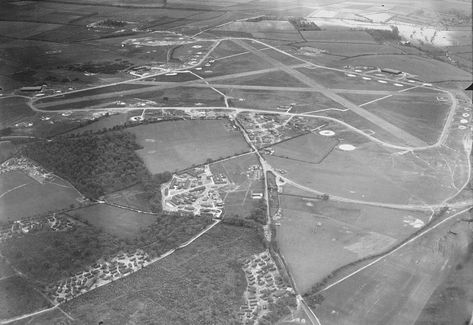RAF Tarrant Rushton.

Tarrant Rushton airfield was situated to the east of Blandford Forum, Dorset, set on the top of a hill with expansive views across Blandford Camp and Badbury Rings (Iron Age hill fort). The building of the airfield that was to become the home of 'C' Squadron commenced in May 1942, the airfield being intended for the use of airborne forces of 38 Wing RAF. On 17 May 1943 the base was handed over while still unfinished. Glider operations finally started in October 1943 and continued until 1945.
Horsa gliders from Tarrant Rushton left for France on the eve of D-Day, to begin Operation Tonga with an action that would later become known as Pegasus Bridge. Among the glider pilots was Jim Wallwork, on a Horsa nicknamed Lady Irene. The Tarrant Rushton gliders landed in occupied France shortly after midnight. Wallwork's aircraft was the first to touch down, but it landed heavily: the force of the impact catapulted both Wallwork and his co-pilot John Ainsworth through the front of the cockpit. Although stunned, this made them the first Allied troops to touch French soil on D-Day.
Hamilcar gliders from Tarrant Rushton arrive on Drop Zone 'N' carrying Tetrarch tanks, 6 June 1944.As part of Operation Tonga, a few Tetrarch tanks of 6th Airborne's Reconnaissance Regiment were also flown from Tarrant Rushton in Hamilcar gliders, towed by Halifax bombers, to land on the French coast near the mouth of the Orne river.
Other gliders were later flown from the airfield to Arnhem to take part in Operation Market Garden. During the closing stages of World War II, aircraft were used for SOE operations.
In September 1946 the airfield was placed on Care and Maintenance status until abandoned in December 1947.
Horsa gliders from Tarrant Rushton left for France on the eve of D-Day, to begin Operation Tonga with an action that would later become known as Pegasus Bridge. Among the glider pilots was Jim Wallwork, on a Horsa nicknamed Lady Irene. The Tarrant Rushton gliders landed in occupied France shortly after midnight. Wallwork's aircraft was the first to touch down, but it landed heavily: the force of the impact catapulted both Wallwork and his co-pilot John Ainsworth through the front of the cockpit. Although stunned, this made them the first Allied troops to touch French soil on D-Day.
Hamilcar gliders from Tarrant Rushton arrive on Drop Zone 'N' carrying Tetrarch tanks, 6 June 1944.As part of Operation Tonga, a few Tetrarch tanks of 6th Airborne's Reconnaissance Regiment were also flown from Tarrant Rushton in Hamilcar gliders, towed by Halifax bombers, to land on the French coast near the mouth of the Orne river.
Other gliders were later flown from the airfield to Arnhem to take part in Operation Market Garden. During the closing stages of World War II, aircraft were used for SOE operations.
In September 1946 the airfield was placed on Care and Maintenance status until abandoned in December 1947.